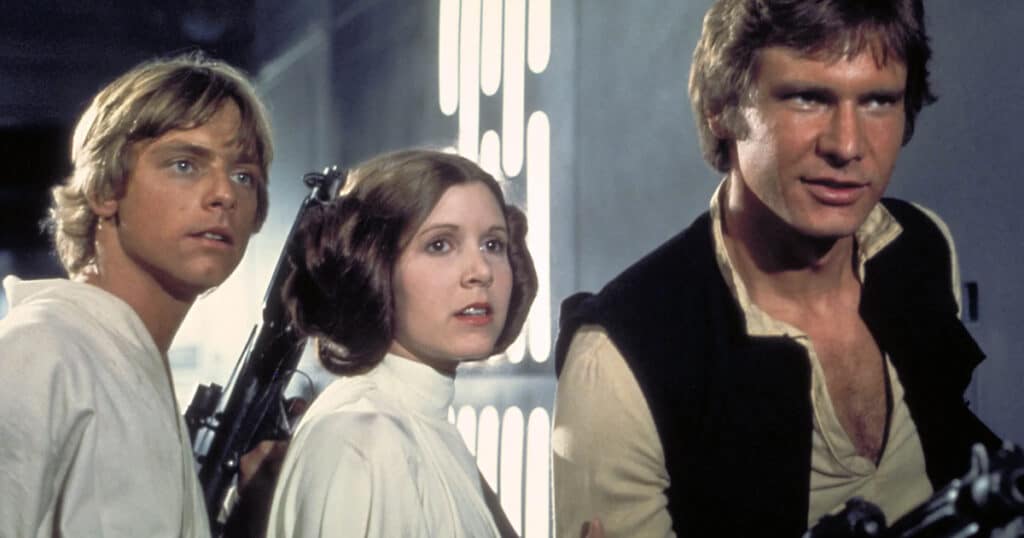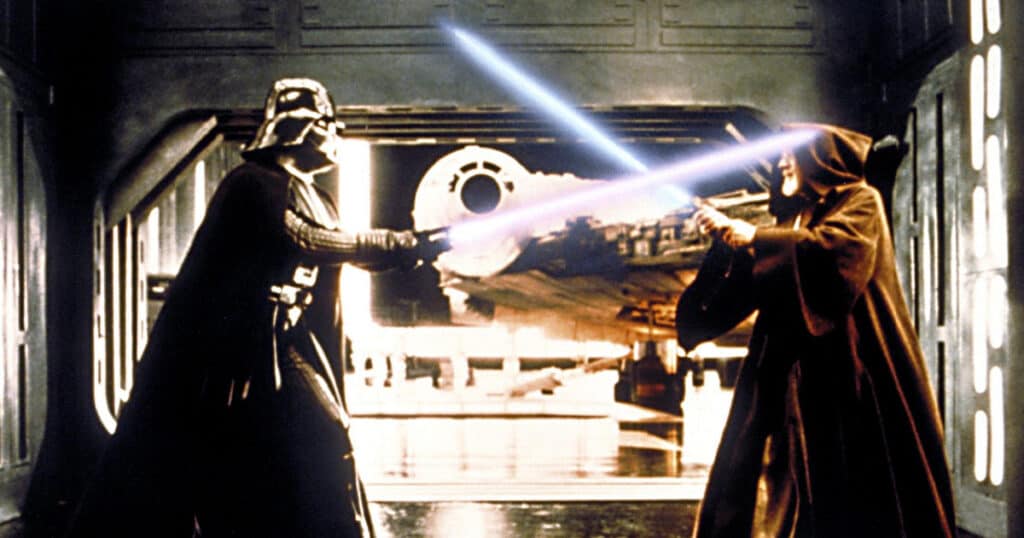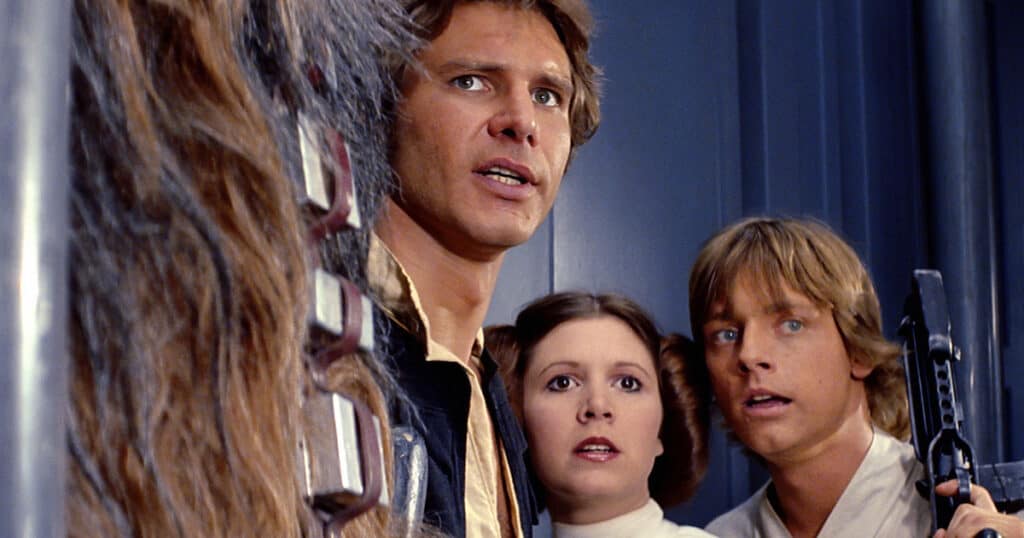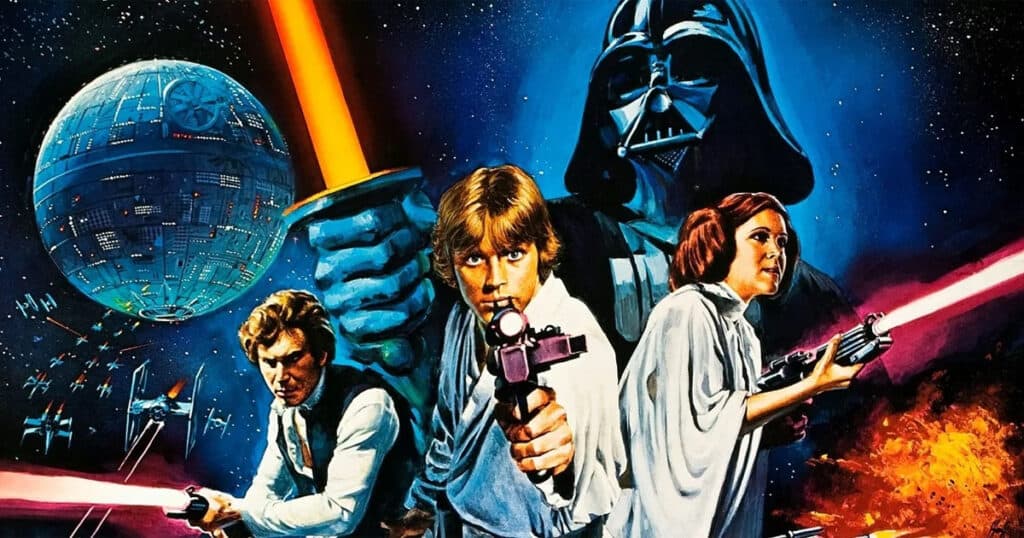What can be said about Star Wars: A New Hope that hasn’t been said before? How many different times can it be stated how George Lucas’ film changed pop culture, the movie business, most of our lives, the whole works? It’s hard to think of a movie – and the franchise it spawned – that’s been picked over, analyzed, dissected more than Star Wars. And yet here we are!
So why go over such familiar territory again? Maybe it’s because the Star Wars films – and we’re talking about the original trilogy here – capture our imagination in ways no other movies can. Better movies have been made, yes, but how many of them transport us so vividly into another universe, one that’s so foreign and yet so familiar? Star Wars puts a smile on the faces of those who love it, and that’s probably why we keep revisiting it over and over again. Like a great song you can listen to on repeat, there’s just no getting tired of the things that bring joy to your heart.
We all have our favorites in the trilogy – plenty of people will argue the sequel, The Empire Strikes Back, is the superior overall film, while some will always stick up rigorously for the flawed but boisterous Return of the Jedi. But there will always be a special place in the heart for the one that started it all. A movie that, no matter how many times you’ve seen it, still feels as vibrant and innovative as it did a couple dozen viewings ago. A movie that might actually be perfect – though it can be argued that too much tinkering by its creator has lessened some of its original greatness. But to A New Hope’s credit, even those special editions and their largely unnecessary alterations haven’t truly diluted the quality of the film. No matter what, A New Hope remains a bona fide classic, and no amount of cosmetic updates can change that. Well, one can hope…
Many of us can’t remember the first time we saw A New Hope; it’s just always been there. It might as well have been playing in the background when we were born. Those of you lucky enough to have seen A New Hope in the theater upon its initial release will no doubt have zero trouble recollecting that day. For the rest of us, it’s been like an omnipresent fixture in our lives. When you’re young, you enjoy movies based on superficial elements: the colors, the sounds, the action, the glorious eventfulness of it all. As we get a little more mature, we peer deeper, past the razzle-dazzle, searching for more substantial pleasures: story, character, drama. Star Wars is the wonderful melding of those shiny superficial and dramatic elements, a glorious marriage of style and substance where imaginative storytelling and mind-blowing technical efficiency combine for an experience that still feels like pure magic. It’s the ultra rare movie where every button pushed seems right, every manipulation is expertly accomplished. It “wows” us with its ideas, seemingly inventing an entirely new genre even as the stories it tells are older than us, inspired as they are by serials, legends, and science-fiction tales from, well, a long time ago…
Outer space will always be the ultimate playground, and A New Hope tells us early and often that it will show us the stars like nothing has before. We’re thrust into an intimidating scenario where a ship is pursued by an almost comically larger battleship, and we instinctively know which one is housing the good guys. Five minutes into the movie, we see this will be a David and Goliath story, the underdogs against the favorites – persistent good versus all-consuming evil. The appearance of Darth Vader solidifies this: he is darkness personified, a malevolent presence that will loom over everything else in the movie. Of course now we all know Vader’s complicated – some might say unneeded – backstory, but in A New Hope he’s just a deadly force to be reckoned with.

The very clear menace of Darth Vader is contrasted by the boyish impetuousness of Luke Skywalker, our protagonist, who will take the tried and true hero’s journey from nobody to savior. Luke has a destiny that calls to him and, of course, he answers – even while being woefully unprepared for what it will reveal to him and take out of him. He’s got the arrogance of youth on his side, though the wide-eyed look of wonder and surprise he sports throughout the film betrays that he really is just a kid way out of his element. But it wouldn’t be as much fun if we had a self-assured lead who knew exactly what he was doing the entire time, would it?
Luke can’t take the journey alone, so in the tradition of all great adventure stories, he’s gifted with a team, one that quickly evolves into an unlikely and somewhat dysfunctional family. There’s the wise older man, the mentor, who knows the secrets of the world he’s bringing the foolish boy into. There are the affable sidekicks, comic relief who bumble noisily from one dangerous scenario to the next, and who against all odds indeed prove to be productive and crucial members of the family time and time again.
Of course, there’s a love interest – and let’s remember here that we’re just talking about the first film, you guys – and she’s got as much heart and courage as anyone else. She’s a princess, yes, but she’s a rebel at heart – a beauty with an acid tongue who stares down the bad guys and seems to know better than anyone that evil can never triumph over good, not for long.
And then there’s the rogue. The confident bad boy who has all the answers – at least, so he thinks. His name is Han Solo, and before you know it he’ll be the prototype for dozens upon dozens of smart aleck scoundrels in movies, television and literature for decades to come. Naturally, the glint of mischief in his eye and his overall aura of detachment hides a heart of gold and the soul of a fighter, and the fact that he values something bigger than himself will not surprise the audience, but it might well surprise him.

The introduction of Han – and his tough-as-nails right hand man, er, Wookie, Chewbacca – is a crucial one in the film. Up until now, the story has moved us with its earnestness and innocence. Yes, it’s been funny, and it’s also shown us some surprisingly grim things (ex: Owen and Beru), but it has kept up the veneer of a brighter-than-usual family film. But here the movie announces it’s going to surprise us some more. Setting us in a spaceport apparently housing some very scummy and villainous characters, A New Hope brings a brand new vibe to the proceedings, a playfulness that immediately cements the film as the ultimate crowd-pleaser.
The Mos Eisley cantina and its population of drunken, chatty aliens completely opens up the world of the movie. We perhaps knew we’d be seeing some fantastical sights in the film, and aliens almost certainly were on the menu, but George Lucas shrewdly tosses us into something bizarre and wholly familiar: The local watering hole, but filled with creatures we never could have dreamt of. Wouldn’t you know it, they act just like us: rabble rousing, laughing, picking fights for no reason. The scene has been imitated a thousand times since, but never better. You just can’t beat the initial surprise, and even if you’ve seen the movie more times than you can count at this point, you still look forward to this gem of a sequence with childlike anticipation. Even more impressive is the fact Lucas doesn’t overstay his welcome here; though we feel as if we could spend the rest of the film’s running time in the cantina, we’re only there for a few splendid minutes, then we’re moving along.
But back to Han Solo for a minute. We’ve just met this guy, and it first it seems like he might be a minor character. He’s going to help our friends out and be done with it. But suddenly, we’re immersed in his story, the main plot is shoved aside for a moment to focus on this pilot’s dilemma. Something about a gangster he owes money to. We then see this guy kill a henchman in cold blood – yes, we’re talking about that version – and quite suddenly we’re seeing a new side to this film. We’re invested in this rogue now, and we find ourselves grateful at the prospect of the rough-edged, cynical mercenary and his growling partner joining our kindly protagonists on their journey. The introduction of Han – and the cantina sequence at large – says to us that this movie isn’t just about old sorcerers, cute robots, and naive young heroes. This movie has a bit of a smirk on its face, a swagger. Han’s macho cockiness, and the events in the cantina, signal definitively that this movie isn’t just for kids. Everyone’s going to love it, they simply have no choice in the matter.

Like most movie classics, A New Hope features a cast that is virtually irreplaceable, with each actor perfectly inhabiting their role in such a way that it’s unimaginable to picture anyone else doing the job. It surely helped that the three leads were more or less unknown at the time, bringing no baggage with them. Mark Hamill, fresh-faced and looking ready for anything. Carrie Fisher, opulent yet fiery. Harrison Ford, ruggedly handsome and all too aware of the fact. They aren’t playing these characters, they are these characters. It’s no wonder people are still so protective of them after all these years.
Naturally, an old hand or two can’t hurt, which is why the casting of Alec Guinness as Obi-Wan Kenobi is so important. Here’s a character who should feel familiar to us, welcoming. When he first removes his cloak, it’s something close to a sigh of relief to see the gifted actor’s face as it’s revealed. His unforgettable voice and the actor’s pleasant demeanor sell us on some of the mumbo-jumbo the old wizard is going on about. This is a man you can trust…
On the other side, you have the imposing voice of James Earl Jones’s Darth Vader, calmly, cooly making demands and predictions, terrifying an entire galaxy. Could Darth Vader possibly sound any other way? No, surely not. And the human face of the evil Empire is a cleverly-cast Peter Cushing, veteran of seemingly hundreds of old British horror thrillers, another familiar face in an unfamiliar world, and yes, another great voice. Never underestimate the importance of an actor with a rigid command of the language.
On a technical level, there was never anything like A New Hope before it, and to this day you have to marvel at what they accomplished in 1977. The movie flawlessly integrates so many eye-popping space ships and space stations into its tapestry that they cease to be special effects, they’re just there. When the great Millennium Falcon goes into hyperdrive, you’re buying every second of its launch. The confidence on display in the filmmaking is so assured it’s any wonder a lot of people, Lucas included, were convinced the movie wouldn’t perform well. George received a lot of grief over the myriad changes he made to his original films, and you might say some of that was well-deserved, but we can never forget just how in tune he was with his audience when he made this picture. Few directors have broken down our defenses with more skill than George Lucas did with his original space opera.
One element that can’t be ignored, and was almost certain to succeed right from the get-go, is the beautiful score by John Williams. Now iconic, it showcases the importance of a good score in a film. It’s impossible to separate it from the movie, and vice versa, and combined with his score for Jaws two years prior it solidified Williams as the premier composer of Hollywood blockbusters, perhaps for all time.
But for all its technical prowess, A New Hope shines so bright thanks to its humanity, and in the recognizable emotions from man, alien and machine alike. (examples: Chewie scares the mouse droid away then shrugs; the Jawas bartering with Luke and Owen; R2-D2 whining as 3PO leaves him) The big moments deserve the reverence they receive from the audience (ex: Han coming in to save Luke at the end; Luke seeing Obi-Wan struck down), but sometimes it’s the clever little details and sight gags that truly earn our gratitude. (ex: the chess game with Chewie, the stormtrooper saying “open the blast doors, open the blast doors!”) Yes, this is a movie that always feels alive. It’s not content to be just another distraction from your world; it wants to bring you into its own and show you the time of your life.
So what can be said about A New Hope that hasn’t been said before? Maybe nothing. This wasn’t an attempt to shed new light on it; this was just another appreciation of a great work of art by some fans who are indebted to Lucas and his incredible collaborators. More than anything, it’s a movie you can count on, and not unlike its characters who are true believers, we find it heartening to know the Force will be with us, always.
Originally published at https://www.joblo.com/star-wars-a-new-hope-revisited/




